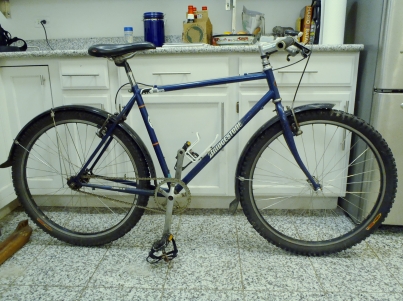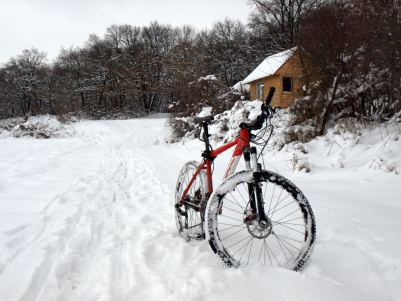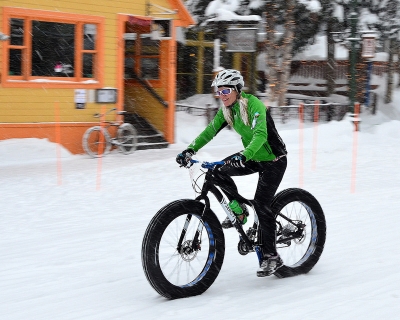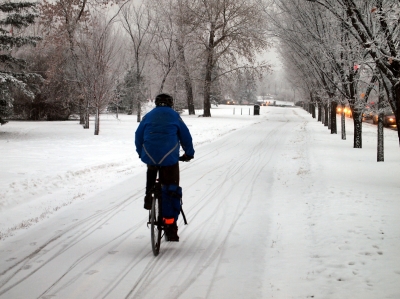10 Tips for Surviving Winter Riding
Once the weather turns cold, it doesn’t matter what kind of riding you’re doing: you have to make some changes if you want to stay on your bike through the winter. Whether that means you want to keep commuting through the cold, stay off the rollers as much as possible for road training, or delve into some winter off-road cycling, there’s a few things any cyclist can do to survive the winter.
No matter what winter means for your area, you can be assured that somebody is out riding in worse conditions than you are. Year-round cyclists are a notoriously hearty bunch who don’t let a little snow, ice, sleet, or wind get in their way. If you make just a few changes to your riding, you too can keep going through the winter happy, warm, and healthy!
Here are some tips, tricks, and must-haves for surviving winter riding:
Choose A Bike
When it comes to choosing a bike for winter, you have some options:

A Winter Beater Bike.
The All-Important Beater:
Winter riding is a great excuse (as if you needed one) to get another bike! If you do it correctly, this bike will be the cheapest one in your whole stable. What you want is a beater bike: something sturdy with big tires that can withstand rock salt, snow plows, and staying outside through it all.
Perfect candidates for this are 1980’s or 90’s mountain bikes; the rigid steel or aluminum framed beasts from your neighbor’s garage or local yard sale. You might have to swap out some tires and throw a new chain on, but with a simple tune-up these bikes make wonderful winter warriors.
If you have a beater bike, you’re well on your way to getting ready for the winter season. This bike might not survive for another year with the abuse you’ll put it through, but that’s why you didn’t spend much on it: you can get another one.

Bicycle in the snow.
Converting Your Trusty Stead:
Maybe you’re brave and want to ride farther and faster in the winter than what an old 80’s mountain bike can accomodate. Maybe you already have eight bikes and could definitely convert that one you never use into a winter beast.
When you’re thinking about getting a bike winter-ready, there’s a few essential things you can do without going crazy with upgrades and purpose-built gear:
Put on some bigger, knobbier tires. On a road bike, you’ll be dealing with tire clearance issues pretty fast. If you can fit them, though, some 700x28c or 32c cyclocross tires will add traction and confidence to your riding in winter weather. For mountain bikes, the tires you have on already will serve you pretty well until you start dealing with more intense conditions. Then you’ll have to start thinking about tires more seriously.
Be nice to your chain. You want a good, wet lube for winter riding. Those dry lubes are great for sunny summer days, but once your day consists of drizzle (or worse) you want something that can keep your drivetrain happy for longer.
Lower that tire pressure! Don’t be riding on your max PSI through crappy weather. Even lowering 10-20psi will improve traction and handling in adverse conditions.
Clean your stead. Wash that salt and grime off your bike. Even if it’s freezing outside and you can’t get to a hose, a bucket of hot water and a rag can go a long way to preserving your components.
Buying purpose built:
Maybe you’re committed to winter riding for this year and every year from now on. Maybe you’ve ridden a beater for a couple seasons and really think it’s time to get serious. Here are some things to think about when buying a purpose-built winter bike:
Pick a frame.
Cyclocross bikes with some serious tire clearance are fun to ride and versatile. They’re also fun and useful year-round.
A 26” or 29” mountain bike frame is also versatile. If you decide winter riding isn’t for you, it’s always possible to just use this one for off-road riding year round.
Want to go crazy? Fat bikes are awesome for serious winter riding and will certainly start a conversation wherever you take it!
Pick your drivetrain.
A (not super expensive) externally geared drivetrain will last for a while on a winter bike if you take care of it.
A single speed or fixed gear rig will be easy to maintain for a winter bike! You can even spend a little more on getting awesome components this way.
An internally gear hub (IGH) is an awesome piece of hardware for winter riding. Because everything is contained, you don’t expose all the parts to winter wear-and-tear. You can shift while stopped, too, which is great for traction and ease. Nice ones don’t come cheap, though, so be careful here.
Whatever specifics you choose for your purpose-built rig, make sure it has attachment points for fenders and racks. Keep durability in mind, a little ahead of performance for this bike. Winter really beats bikes up, so you want to make sure this one is solid.
Get Some Fenders
If you’re going to ride in any kind of bad conditions, having a bike with fenders is a good idea. This is never more true than in the winter. Fenders protect your bike’s components but they also protect you from spray off the road as you ride. If the precipitation from above doesn’t soak you, the stuff off the road will, unless you have a trusty set of fenders.
We’ve outlined a few fender options for you, from lust-worthy to budget-friendly:
Lust-Worthy: If you’re used to shelling out big bucks for bike parts, you’ll be happy to know that even really nice bike fenders can be had to less than 100 bucks. These fenders from Velo Orange are made from hammered aluminum or stainless steel, meaning they won’t rust through the winter weather. These fenders provide supreme protection and will last for years and years if you take care of them.
TIP: If your fenders rattle too much, look around for leather washers to put between the fender and all attachment points. These deaden the noise quite well.
Bang-For-Your-Buck:
Plastic (SKS calls them ‘chromoplastic’) fenders are an awesome material for fenders. Since they aren’t metal, they won’t rust and they’re a lot quieter than their more expensive cousins. SKS Fenders are a great option for riders who want a slightly more budget-friendly option:
The Cheap Way Out:
Ever since people started biking in the rain, they’ve made bike fenders and mud flaps out of pretty much every material you can imagine. With a pair of scissors and a milk jug, you can cut yourself out a decent set of fenders just for the cost of milk. This is a good option if you’re looking to save on fenders.
Choose Your Tires
You have lots of options when it comes to tires for winter. Everything from a slightly wider tire than you’d run the rest of the year to wide, studded tires are great options for winter riding. It really depends what the weather conditions demand of you:
For rain:
If all you’re going to be faced with is a little cold rain, consider either keeping the tires you were using or switching out for some slightly wider or more grippy tires. For example, if you’re running 23s on our road bike all year long, maybe put some 28s on to just give yourself a little more confidence in cold, wet conditions. The good news is, cold rain isn’t much different than a summer thunderstorm, so you should be good to go.
For rain/sleet/light snow:
Many parts of the US will get a ‘wintry mix’ of precipitation throughout the winter. This means you might not know what to expect when you head out the door each day, and that your morning and evening rides might be much different.
For this, a knobby 26” tire on a mountain bike or some cyclocross tires on a road bike that can accommodate them should do the trick. Something like 700x38c cyclocross tires make for excellent traction in a range of conditions, just like what cyclocross throws at them on a closed course.

Riding a Fat Bike.
For serious snow and/or ice:
When conditions get really bad, you can start thinking about purpose-built tires for snow and ice. A few companies make studded bicycle tires, such as Nokian Tires out of Finland, http://www.nokiantires.com/ . These tires don’t come cheap, but for serious winter riding they make a huge difference.
For the “It snowed two feet last night. Honestly, I was expecting more” folks: If you have the money for it, your choices becomes a little easier here. Get yourself a fat bike with huge tires, like something from 9:Zero:7 or Surly. If you’re committed to riding in these conditions, these bikes can accommodate you.
Wear a Hat
Keeping your head covered with a helmet and insulating headwear is a must for winter riding. The temperature and wind are going to dictate how intense you need to get with this. For temperatures that aren’t too bad (down to about freezing), you can get away with whatever beanie you wear everyday. Once it gets colder than that, consider something windproof on top of being warm. Mountain Hardwear makes a great windproof hat that fits under your helmet.
Once it’s cold, you also want to cover your face. A balaclava is great for winter riding, and if it gets really cold you can use a trick used by skiers and snowboarders: a thin layer of vaseline on your face will help keep your skin from getting chapped in cold weather.
Upgrade Those Lights
The days are already shorter in the winter, so chances are, if you’re out riding, it’s bound to get dark. Dusk and dawn riding in the winter is amazing: it’s quiet out and calm, with only wispy trails from wood stoves gliding through the still air. To really enjoy it, though, you’re going to need lights.
Here are a few suggestions, depending on your needs. The lust-worthy options are great if you need serious power to cut through nighttime snow; the more budget-friendly options are great for someone who just needs to be seen going down the street.
Lust-worthy:
If you need bright, intense power from your light setup, look no further than NiteRider’s selection: The NiteRiderPro 3600 can put out serious light for a long time, for a lust-worthy price.
Value-priced:
Planet Bike makes some good lights at great prices. The Blaze 2 watt light is great for seeing a little, but also being seen.
If you want a taillight to go with your blaze, the PB Superflash has been a the go-to for budget-friendly taillights for years. They’re bright, last a long time, and can even be charged via USB while you’re at work!
Wear Warm Gloves
To get an idea of how many options are out there for cycling gloves, just check out Amazon's selection of them. There's a huge variation in styles, so you need to make you pick out a pair that fits your needs.
You’ll find everything from lightweight gloves for a little cold to intense lobster gloves for anything nature can throw at a cyclist. Once the weather gets really cold, lobster gloves are great: you get the warmth advantage of mittens but with a split in the middle so you can operate everything you need to on the bike. They’re a great option for serious cold weather riding.
If you’re just looking for something simple and warm, liners for ski and snowboard gloves make great winter riding gloves. They’re lightweight, quick-drying, and warm, but the price won’t set you back as far as purpose-built riding gloves will.
Choose Your Clothing
With clothing for winter riding, the most important thing is to not overdress. This might surprise you since you’re thinking about whizzing along, wind in your face, freezing. But in reality, once you get past the initial hurdle of wind, biking in the cold can actually be a pretty warm proposition.
You’re going to layer things that are both windproof and breath well. Here’s a guide:
Tops
Your top half isn’t going to be doing quite as much work as your bottom half, so it’s important to keep your core warm up top. If you really need top-notch warmth, Rapha makes an amazing winter jersey. For less intense and more budget-friendly options, look for a hi-vis cycling jacket that will keep the wind off, like this one from Canari. Underneath that, a warm baselayer should keep you nice and toasty.
Bottoms
If you want performance wear for cycling, a pair of wind-resistant tights, like these from Gore are a great choice. If you’re commuting and want something warm on under street clothes, any thermal baselayers make for warm cycling clothing for short distances. Again, your mileage and dedication to winter riding will determine how nice your gear needs to be.
Shoes
Many people shy away from clipless pedals for winter riding, which makes sense: you can put your foot down quicker and have a more traction when your feet hit the ground. Therefore, any waterproof shoe or boot with decent traction and comfort will work for winter riding. For the more dedicated winter cyclist, you can also buy overshoes that go over your existing cycling footwear. These are a great option if you’re still training all winter long.
Stay Fueled
When you cover miles and miles in the warm months, it’s easy to remember to drink water and stay fueled with gels or bars. Once winter rolls around, many people forget to drink water. You get dehydrated just as fast or faster in the winter, so you need to keep plenty of water on hand. Keeping your body warm burns calories too, so make sure to keep something to eat with you as well.
If you really want to embrace winter riding decadence, consider getting a thermos that will fit in a bottle cage and putting your favorite hot beverage in it for midway through the ride. A cup of hot coffee when the wind is really blowing will make any ride better.
Change Your Riding Style

Winter Bike Commuting.
One of the biggest things people forget about when riding in the winter is that they need to change not just what they wear and what they ride, but also how they ride. In the winter, make sure to allow more time to get where you’re going. Anything can hold you up: traffic, slick ice, or mechanical problems.
When you’re riding, SLOW DOWN. Tires don’t grip as well on slick, icy, or rough surfaces and your brakes aren’t going to work as well as they do when it’s sunny and dry out.
When you’re thinking about handling in winter conditions, do the same things you would do when you’re driving a car: slow down, anticipate turns, and try to keep traction. If you start to slide, don’t throw on your brakes, either; that’s a great way to end up on the icy ground in an instant.
Have A Backup Plan

Have a Backup Plan.
Sometimes, the world will conspire against you when you’re out riding in the winter. The last thing you want to do is be 15 miles outside of town with a busted drivetrain and no way to get back home in the freezing weather.
Always have a backup plan. If you’re commuting, befriend a co-worker that’s willing to pick you up if you end up stranded or take you home if it happens to snow 6 inches while you’re at work. If you can’t do that, have a plan to ride public transportation!
If you’re road riding, tell a friend where you’re going and have a plan to get picked up if you’re stranded. Always leave yourself a way out of any situation, especially when you’re dealing with bad weather and slick roads.
